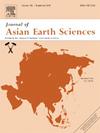Genesis and geological significance of pyrite in the First Member of the Cretaceous Qingshankou formation of the Songliao Basin, NE China
IF 2.4
3区 地球科学
Q2 GEOSCIENCES, MULTIDISCIPLINARY
引用次数: 0
Abstract
Pyrite is an important component for reconstructing the biogeochemical conditions and sedimentary environments of the earth’s surface in the past. The study on pyrite of Cretaceous Qingshankou Formation in the Songliao Basin not only helps elucidate the depositional processes of high-quality source rocks in the area, but is also important for reconstructing the Cretaceous paleoenvironment. Pyrite in the Qingshankou Formation includes euhedral pyrite, anhedral pyrite, fine-grained pyrite aggregates, pyrite framboids and polyframboids. The euhedral pyrite can be further divided into authigenic and secondary pyrite. Authigenic euhedral pyrite is directly precipitated from solution, while secondary euhedral pyrite is formed by recrystallization of pyrite framboids. The secondary pyrite can be further divided into compaction type and cementation type, indicating that the transformation of pyrite framboids into secondary euhedral pyrite is controlled by compaction and cementation, respectively. Anhedral pyrite is usually precipitated on the surface of iron-rich clay minerals (e.g., chlorite), or by metasomatism of other minerals, biological skeletons, and microorganisms. Framboidal pyrite is formed from greigite, and the amount, number of microcrystalline layers and particle size are related to the flow intensity of the water. This study provides a new understanding of the genetic mechanism of different types of pyrite.

松辽盆地白垩系青山口组一段黄铁矿成因及地质意义
黄铁矿是重建过去地球表面生物地球化学条件和沉积环境的重要成分。松辽盆地白垩系青山口组黄铁矿研究不仅有助于阐明该区优质烃源岩的沉积过程,而且对重建白垩系古环境具有重要意义。青山口组黄铁矿包括自面体黄铁矿、自面体黄铁矿、细粒黄铁矿集合体、草莓状黄铁矿和多草莓状黄铁矿。自形黄铁矿又可分为自生黄铁矿和次生黄铁矿。自生自体黄铁矿直接从溶液中析出,次生自体黄铁矿则由草莓状黄铁矿再结晶形成。次生黄铁矿可进一步分为压实型和胶结型,表明草莓状黄铁矿向次生自体黄铁矿的转变分别受压实和胶结作用的控制。菱形黄铁矿通常沉淀在富铁粘土矿物(如绿泥石)的表面,或由其他矿物、生物骨架和微生物的交代作用形成。草莓状黄铁矿由灰长岩形成,其微晶层数、微晶层数和颗粒大小与水的流动强度有关。本研究对不同类型黄铁矿的成因机制有了新的认识。
本文章由计算机程序翻译,如有差异,请以英文原文为准。
求助全文
约1分钟内获得全文
求助全文
来源期刊

Journal of Asian Earth Sciences
地学-地球科学综合
CiteScore
5.90
自引率
10.00%
发文量
324
审稿时长
71 days
期刊介绍:
Journal of Asian Earth Sciences has an open access mirror journal Journal of Asian Earth Sciences: X, sharing the same aims and scope, editorial team, submission system and rigorous peer review.
The Journal of Asian Earth Sciences is an international interdisciplinary journal devoted to all aspects of research related to the solid Earth Sciences of Asia. The Journal publishes high quality, peer-reviewed scientific papers on the regional geology, tectonics, geochemistry and geophysics of Asia. It will be devoted primarily to research papers but short communications relating to new developments of broad interest, reviews and book reviews will also be included. Papers must have international appeal and should present work of more than local significance.
The scope includes deep processes of the Asian continent and its adjacent oceans; seismology and earthquakes; orogeny, magmatism, metamorphism and volcanism; growth, deformation and destruction of the Asian crust; crust-mantle interaction; evolution of life (early life, biostratigraphy, biogeography and mass-extinction); fluids, fluxes and reservoirs of mineral and energy resources; surface processes (weathering, erosion, transport and deposition of sediments) and resulting geomorphology; and the response of the Earth to global climate change as viewed within the Asian continent and surrounding oceans.
 求助内容:
求助内容: 应助结果提醒方式:
应助结果提醒方式:


